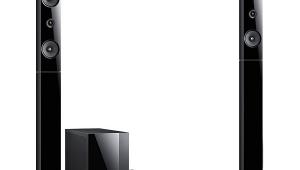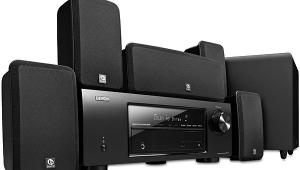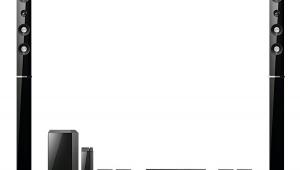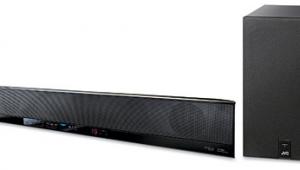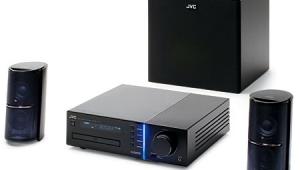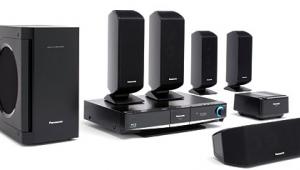Onkyo HT-S990THX Integrated Home Theater System
A recent story on Salon.com discussed the chocolate craze. Apparently, there's a new category of high-end chocolate, writes Oliver Broudy in "The Sweet Smell of Snobbery." It comes complete with its own specs—the higher the percentage of cocoa solids, the better. There's jargon, of course, including terroir, which refers to the cocoa-growing region. And there are postprandial rituals in which celebrants are encouraged to taste 400 different flavors in one little bite. While I may ridicule this phenomenon, I would never condemn it, as long as people have a good time. Also, I happen to love dark chocolate.

Some people describe the Onkyo HT-S990THX as the first THX-certified home-theater-in-a-box system. Before I go any further, please note that I'm using the HTIB moniker just this once so you'll know what I'm talking about. The Onkyo and THX people prefer, not unreasonably, to call this an "integrated home theater system." Their nomenclature rules from this moment forward.
Is a THX-certified integrated system the electronic equivalent of high-end chocolate? It's a tempting analogy, with your average compact system as the humble Hershey bar and the Onkyo HT-S990THX as, say, Cte d'Or Noir de Noir Intense. But I'm going to walk away from this analogy for one simple reason: There's nothing wrong with a Hershey bar, even if the cocoa content is on the light side. But the integrated-system category is riddled with inadequacy, and, short of banning the nasty things by legal fiat, the only way to improve the situation is to invent a better mousetrap.
I'm talking about an integrated surround system that transcends its genre by performing up to THX specifications. It should have monster bass, a credible soundfield, good dynamics, and an affordable price. Not ridiculously affordable—Onkyo's list price is still in the low four figures. But the street price might well be in the high three figures if you look around.
Great Big Boy
The HT-S990THX came, indefensibly, in a single 143-pound carton. Don't try to handle it by yourself. If one lands in your front yard, open it there and carry the pieces into the house.
It is a 7.1-channel system with three woofer-tweeter-woofer speakers for the front left, center, and right channels. Four smaller monitors using similar drivers—except with just one woofer each—handle the side surround and rear surround channels. All of the midwoofers are made of A-OMF (Advanced Onkyo Micro Fiber).
The receiver is an Onkyo HT-R940. Not sold separately, it has a higher power rating than most budget receivers and a features set that's stronger in some areas (cool THX listening modes) than in others (no onscreen menus or HDMI). A DVD player is not included—add that to your budget if you're starting a system from scratch. XM plug-and-play compatibility is a plus—to take advantage of it, add $20 for the antenna.
Fit and finish are par for budget gear. The sub is on the light side (not that I'm complaining). The speakers and receiver have good plastic-nut binding posts, as opposed to annoying wire clips. And the speakers and sub have removable grilles and gray trim to relieve the visual black-vinyl monotony.
Setup is simple in most ways. Supplied color-coded cables make it easy to ensure that you wire every channel correctly (as long as you don't wire anything out of phase). The sub is custom designed to go with the rest of the system, so you needn't worry about what crossover to use—THX has done the thinking for you. There's one jack on the sub to receive the interconnect cable. A volume knob is the only control.
In the absence of an onscreen display, the receiver offers only a front-panel display for setup and other menus. That means you'll have to read the manual to figure out which navigation buttons to press in what sequence when you set the speaker distance and channel levels. At least you don't have to select large or small for the speakers—the THX preference of small speakers and sub on rules the roost.
Onkyo's sister brand Integra provided the signal source for this review, a DPS-10.5 universal player. Ironically, this bleeding-edge reference component costs more than the entire 7.1-channel system it fed. Operating the player and receiver with one remote was convenient.
Reference-Quality Action
What can roughly $1,000 worth of THX-certified joy do for the Dolby Digital 5.1 soundtrack of a slightly above-average action movie? Firewall with Harrison Ford provided the answer. I scribbled a full page of notes. The ones that maintained morning-after legibility reminded me of the pounding synth pulses that accompany the opening frames. With a normal HTIB, I would have hunted for the volume-down key. Instead, I just enjoyed the portentously bombastic moment for what it was intended to be.
I see another note: "Bass drum! Dum dum!" That means I liked it, both quantitatively and qualitatively. It was a fatty, led by the impact of the mallet on the drum skin and followed by a tightly resounding note. A more expensive sub might have delivered a cleaner pitch, but the attack and dynamic envelope were perfect. When kidnappers violently took possession of a screaming family, the orchestra filled the air with dissonant brass, pounding tympani, and then—nothing. There was no subwoofer overhang in the shocking silence.
A rainstorm on the highway was neither a vague mush of sound nor a pinpoint-perfect pointillist painting of individual raindrops. Instead, I got a sense of the mixer combining the general sound of the storm with a few specific pieces of closer-miked sounds, accompanied by a small swooshing crescendo in the left surround channel preceding an abrupt cut to another scene. And that was just the first 20 minutes.
Jonathan Demme's film of a Neil Young dream concert was my main music video selection. With the Dolby Digital soundtrack of the Heart of Gold DVD, I switched the THX re-EQ circuit in and out. At first, it seemed to justify an emotionally gratifying volume hike. But this was not loud electric music, and I soon realized that the prevalent acoustic guitars sounded better with the re-EQ switched off. This was also my preference with Firewall. After a while, the selfish listener in me overruled the audio critic, and I left it off for everything that followed.
Hammered
The percussiveness of Daniel Barenboim's piano came to the fore on EMI's nine-CD boxed set of Beethoven chamber works for piano, violin, and cello. Recorded mostly at Abbey Road, the set has a melting beauty that sounded vague at first. But, when I turned up the volume, Pinchas Zuckerman's violin and Jacqueline du Pré's cello emerged mellow and woody, not strident. And then I heard the piano's hammers hitting the strings with each note. Rediscovering this familiar recording in this way was quite pleasurable and spoke well of the system's sure-footed subtlety.
Following that train of thought onto a larger scale, I tried a piano concerto. The PentaTone SACD of Beethoven's Piano Concerto No. 2 is a four-channel 1974 recording. Despite the lack of a center channel, Stephen Kovacevich's piano emerged as a physical presence that made me aware of the body of the piano, as well as the hammers. The BBC Symphony Orchestra's sound was extremely well shaped. It was also well blended—smoothing over distinctions between violins, violas, and cellos, streaks of tone color that would be more prominent with an ultimate high-rez system. But this is a minor quibble. Overall, the presentation was totally involving.
 Steely Dan's Everything Must Go is a treat in the DVD-Audio surround mix. The system didn't overplay the rhythm section's groove. But, when I switched from the stereo downmix (coaxial in) to the surround track (multi in), the soundstage suddenly opened up like a flower in time-lapse photography, acquiring not only space but also the lushness that makes high-rez surround an underrated joy. Donald Fagen's distinctive voice was spot-on, its normal nasality not exaggerated, and its timbre perfectly natural.
Steely Dan's Everything Must Go is a treat in the DVD-Audio surround mix. The system didn't overplay the rhythm section's groove. But, when I switched from the stereo downmix (coaxial in) to the surround track (multi in), the soundstage suddenly opened up like a flower in time-lapse photography, acquiring not only space but also the lushness that makes high-rez surround an underrated joy. Donald Fagen's distinctive voice was spot-on, its normal nasality not exaggerated, and its timbre perfectly natural.
Deadwing by Porcupine Tree is a state-of-the-art rock surround mix. The Onkyo system didn't make a big deal of the difference between the lossless DVD-Audio and lossy DTS soundtracks (although neither has any other system I've played them on). There's a bit more dynamic range than an average rock recording, which the system easily exploited. While this disc is slick and painless on nearly any equipment, the Onkyo system made it feel bigger. As a result, I turned up the volume and stopped being a critic for a while.
On the whole, the HT-S990THX aced most kinds of program material. I didn't feel driven toward one particular kind of music. Nor did I find myself avoiding any particular kind of movie. The one thing missing—despite the system's pleasing performance with DVD-Audio and SACD material—was that final increment of transparency and brilliance that enables high-end gear to earn its price tag. But the system's objective balance and versatility were ample compensation. So, yes, I liked this mamajama. Onkyo has proven that THX has much to offer in the integrated system genre. You could easily pay more and get less.
* Audio editor Mark Fleischmann is also the author of the annually updated book Practical Home Theater (www.quietriverpress.com).
Highlights
• First THX-certified integrated home theater system
• Excellent bass
• Well-balanced performance
- Log in or register to post comments
